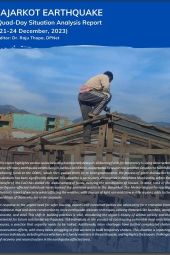Jajarkot Earthquake : Quad-Day Situation Report (21-24 Dec)
Summary
This report highlights various issues including bureaucratic delays in disbursing funds for temporary housing construction have left many earthquake-affected people living in risky conditions, exacerbated by severe cold weather. Despite the NDRRMA releasing funds to the DDMC, which then passed them on to local governments, the process of grant distribution to individuals has been significantly delayed. This situation is particularly pronounced in Banphikot Municipality, where the transfer of the CAO has stalled the disbursement of funds, delaying the construction of houses. To date, none of the earthquake-affected individuals have received the promised grants in the Banphikot. The Meteorological Forecasting Division's report of westerly winds affecting the weather, with chances of light rain and snow in hilly regions, adds to the hardships of those who live under tarpaulin.
In response to the urgent need for safer housing, experts and concerned parties are advocating for a transition from traditional mud and stone construction to more earthquake-resistant techniques, utilizing materials like bamboo, wood, concrete, and steel. This shift in building practices is vital, considering the region's history of seismic activity and the potential for future substantial earthquakes. Still individuals in the process of constructing vulnerable mud and stone houses, a practice that urgently needs to be halted. Additionally, labor shortages have further complicated shelter construction efforts, with many locals struggling to find workers to build temporary shelters. This situation is impacting various individuals, including those who have lost family members in the earthquake, and highlights the broader challenges of recovery and reconstruction in the earthquake-affected area.
Categories:
DPNet Publication
Published Year:
2023
